Types of domestic gas: what gas comes to our apartments + features of domestic gas
Gas is present in many areas of life. It uses the engines of vehicles, they heat the premises, it is used as an energy carrier in various household and industrial devices. It would be nice to know what it consists of, what properties it has and what kind of danger this universal type of fuel hides in itself, right?
We will talk about what kind of fuel is supplied to residential premises, consider the types of domestic gas and analyze what is included in its composition. We also recall the operating rules that everyone who uses gas equipment in everyday life needs to know.
The content of the article:
What gas is supplied to residential buildings?
Domestic gas is called the most important raw material necessary for heating water, cooking and organizing a heating system in the home. It is a mixture of combustible gaseous substances and some additional substances.
Varieties of domestic gas
Compared to other energy sources, gas has many advantages: it is quickly ignited, does not emit soot and smoke during combustion, and practically does not contain harmful components and solid impurities. The burning of blue fuel is easy to control.
There are two main types of gas used in domestic conditions:
- Natural. A gaseous substance that is pumped into storage and enters residential facilities through an extensive piping system. It consists mainly of methane and does not change the physical condition from the moment of production to delivery to the direct consumer.
- Liquefied. Propane-butane mixture obtained in the process of oil refining. It is a liquid placed in special tanks for storage or transportation to places where the use of pipes is impossible or economically impractical.
Through centralized heating and gas supply systems, residential gas is supplied with natural gas extracted from the bowels of the earth and previously purified from a number of impurities. This type of fuel is considered the cheapest, affordable and convenient for apartment buildings.

And here liquefied propane-butane mixture high calorific value, but it is much more explosive. Liquid gas cylinders need proper transportation, adjustment and connection. During their operation it is extremely important to observe special safety measures. Often, cylinders or gas holders are installed in private houses, in summer cottages.
Since methane is twice lighter than air, it leaks upward when leaking. The propane-butane mixture, on the contrary, goes down. This must be considered in emergency situations.
Composition and pressure of gas in pipelines
Before you end up in trunk pipelinesleading to residential buildings, natural gas undergoes pre-processing and several degrees of purification. During the procedures, the necessary impurities are added to the fuel, making the composition as effective and safe as possible.

The main share of the fuel mixture is methane. Depending on the region of production, its content varies from 80 to 98% of the total. It is the amount of methane that serves as an indicator of energy quality.
The composition of household gas also includes:
- carbon dioxide;
- propane;
- ethane;
- butane;
- hydrogen sulfide;
- helium.
In addition, fuel may contain a small fraction water vapor and nitrogen. Properties and characteristics are almost completely determined by methane, but can vary under the influence of quantitative and qualitative composition of the mixture.
In gas pipeline systems through which fuel circulates, a very high pressure is created - above 2.5 MPa and up to 10 MPa. Under such pressure, the gas moves over long distances and between settlements.
Since this indicator is unacceptable for domestic consumption, it is significantly reduced when it is received at gas distribution stations by additional purification of methane. So, to consumers, gas moves under pressure up to 5 kPa (low pressure), from 5 kPa to 0.3 MPa (medium range) and 0.3 MPa to 1.2 MPa (high pressure range). We examined pressure standards in the gas pipeline in more detail following material.
Causes of a specific smell of gas
In its pure form, methane does not have a characteristic odor and color. What is added to household gas so that it smells characteristic? It is possible to detect a leak by smelling because a small amount of substances with a sharp unpleasant odor is mixed into the gas.
These substances are called odorants. They give the fuel mixture a specific smell of fresh hay, rotten eggs or rotten cabbage, which warns of the danger and possible leakage of gas in the room.
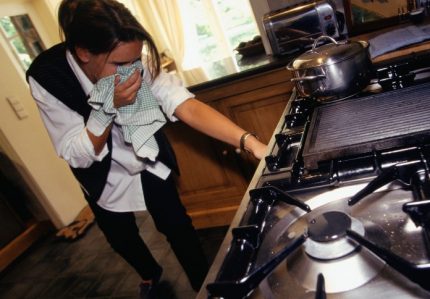
Sulfur-containing organic compounds are used as odorants, most often - ethyl mercaptan or ethanethiol. They are sprayed into the structure of the fuel mixture using special plants during processing.
What is the danger of household gas?
Whatever gas is supplied to residential buildings, through a gas main or from a cylinder, it can be improperly handled deadly.
We recommend that you read the article: [link_webnavoz]Why gas cylinders explode: the main causes of accidents[/ link_webnavoz].

There are almost no toxic substances in the natural gas supplied to the house. But in everyday life there are many cases when a leak causes serious harm to the body or even death. The main reason for this is carbon dioxidethat gets into the room and displaces oxygen from the surrounding area, causing choking.
Another negative feature of methane is high fire and explosion hazard. The risk level is determined by many additional factors, in particular - pressure and ambient temperature.
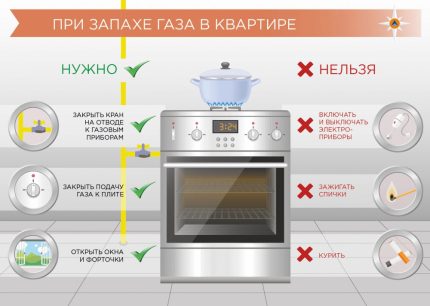
A special danger in closed gassed rooms is electrical equipment, devices operating on batteries and batteries. With a high percentage of methane, even the included mobile phone and laptop can provoke an explosion or fire.
Explosions are so strong that they almost completely destroy housing. Therefore, having heard a characteristic smell in the apartment, it is advisable not to use electrical appliances and turn off the electricity in the switchboard.
What does the color of the flame in the burners indicate?
Flames on a gas stove or in a boiler often have different shades. Color depends on the quality of the gas supplied to the apartment. It is used to judge the physicochemical characteristics of the fuel mixture.
Quality fuel with a homogeneous structure is different uniform burningsaturated in blue fire. Such a gas completely burns out, while emitting the maximum amount of heat and a minimum of harmful substances.
The purity of combustion is affected by the hydrogen content. If reeds appear in the flame red, of orange or yellow colorThis indicates a problem.
There may be two reasons:
- The imbalance in the air-fuel mixture.
- Low energy quality.
The abnormal color of the flame in the burner indicates the presence of unwanted impurities, incomplete combustion of fuel and the formation of carbon monoxide. Therefore, both cases are potentially dangerous.
An imbalance in the fuel mixture can occur due to insufficient or excessive air flow, clogged burner with soot, dust, soot. It happens that gas is supplied to the house low densityunable to provide an optimal level of heating.
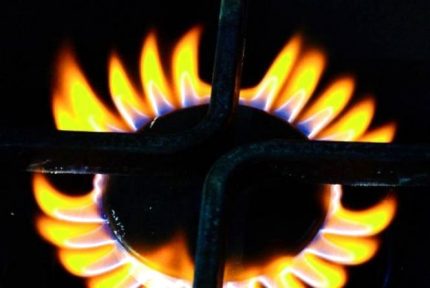
In this situation, for the normal operation of the system large volumes of resources are required, and, therefore, utility bills are growing. Usually the culprits are management companies that increase their income by intentionally lowering the content of hydrocarbon and carbon dioxide in the energy source.
Guidelines for the safe use of gas
In practice, most of the explosions and fires are caused by the human factor, neglect of safety measures when using gas, and negligence in handling gas equipment.
To protect yourself and loved ones, you need to follow a number of norms and generally established rules.This will help prevent explosive situations and all the adverse effects associated with a gas leak.
Rules for the operation of gas equipment
Any gas equipment should be bought only at specialized companies that can present certificates for the sale of this type of product. It is necessary to pay attention to the instructions for safe operation of the device.
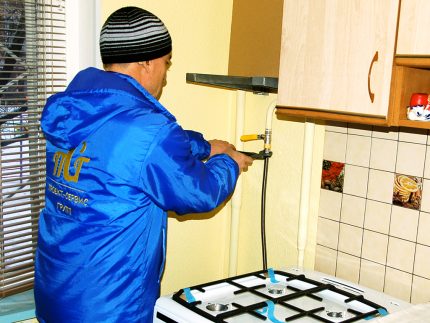
It is important to adhere to the following rules for the operation of gas equipment:
- carefully read the instructions and follow the recommendations indicated in it;
- not use the equipment for other purposes (warm the apartment with a gas stove);
- monitor the performance of devices and ventilation, annually invite specialists to check traction;
- ensure a normal air flow in the room, do not isolate the ventilation holes, do not clutter the gas pipes;
- Do not leave functioning devices unattended, especially in rooms with young children, as well as if the devices are not designed for continuous operation and are not equipped with appropriate automation;
- do not tie clotheslines to gas pipelines;
- shut off gas valves and taps on the pipeline before leaving home; in case of prolonged absence, it is better to turn off the electricity;
- Do not blow out or flood the burner with water or other liquids.
It is very important to regularly check the condition and tightness of hoses, fittings, threaded connections. The optimal length of the flexible hose is not more than 2 meters, the maximum service life is up to 4 years.
The hose must be fitted tightly to the gas valve, but it is not recommended to overtighten the clamping clamp.
We reviewed more recommendations for the safe operation of gas equipment in this article.
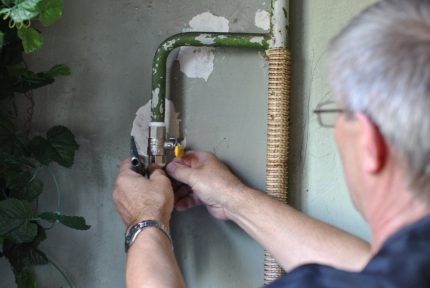
Feeling characteristic the smell of gas in the apartment, it is necessary to immediately shut off the burner taps and valves on the pipeline. You should also open the doors, windows and carefully ventilate the gassed room, making sure that everyone present leaves it quickly.
People affected by gas should be urgently taken to fresh air and first aid provided:
- lay on your back so that your legs are above the body;
- remove tightening clothes;
- cover, rub the chest, bring ammonia;
- when vomiting, turn on its side;
- if possible, drink plenty of water.
You can’t do something that can create a spark or flame: smoke, light a fire, turn on / off electrical appliances, lighting, press the bell button, use mobile devices.
It is advisable to immediately report the incident to the emergency gas service. While rescuers arrive, it is worth warning about the situation of neighbors.
Leak Detection Methods
To detect a gas leak in the room, several proven methods are used. The easiest and most common option is to spend surface inspectionby applying soapy water along the gas pipes. In case of leak in problem areas bubbles form.
The most reliable way to avoid trouble is to install carbon monoxide sensor.
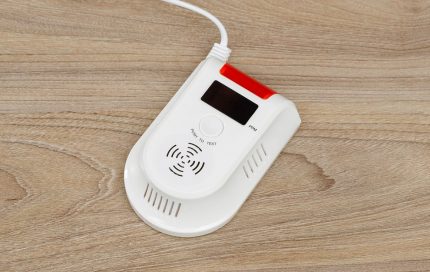
In addition, a leak can be detected by ear or by smell.With a strong leak, the fuel mixture from the pipes breaks out with a whistle. Easy to feel and odor odor specificadded to the fuel structure during reprocessing.
Conclusions and useful video on the topic
What is the route of natural gas from the moment of production to delivery to the final consumer:
Recommendations for the safe operation of gas appliances:
Natural gas supplied to apartments through trunk pipelines is one of the most affordable and profitable types of fuel. It has a high calorific value and does not contain harmful impurities that pollute the surrounding area.
At the same time, gas is a source of increased danger and requires careful handling in everyday life. In order to prevent fire, explosive situations and poisoning as a result of leakage, it is necessary to observe certain safety measures when using gas equipment.
Timely maintenance of gas equipment, ensuring quality ventilation, control over the operation of equipment and competent actions at the time of emergency are the basic rules for the safe use of gas.
Still have questions about the types of domestic gas? Or do you want to supplement this publication with useful information? Write your comments, ask questions to our experts and other users - the feedback form is located below.

 Natural gas odorant: features of odorants, norms and rules for their entry
Natural gas odorant: features of odorants, norms and rules for their entry 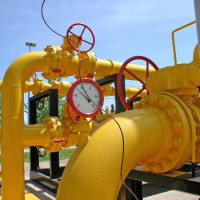 Gas pressure: technical standards + distribution features on the line for gas pressure
Gas pressure: technical standards + distribution features on the line for gas pressure 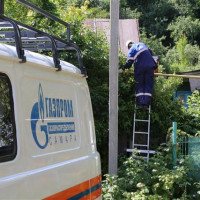 Where to call if there is no gas in the apartment: reasons for disconnection + procedure for the absence of gas
Where to call if there is no gas in the apartment: reasons for disconnection + procedure for the absence of gas  Gas leak: where to call, what can and cannot be done if the apartment smells of gas
Gas leak: where to call, what can and cannot be done if the apartment smells of gas 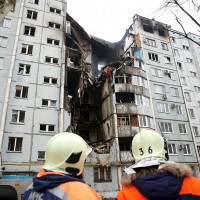 How gas explodes in an apartment: causes of explosions and tips for safe use of gas
How gas explodes in an apartment: causes of explosions and tips for safe use of gas 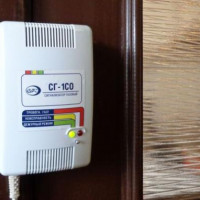 Gas leakage sensor with shutoff valve: device, classification + how to choose and install correctly
Gas leakage sensor with shutoff valve: device, classification + how to choose and install correctly  How much does it cost to connect gas to a private house: the price of organizing gas supply
How much does it cost to connect gas to a private house: the price of organizing gas supply  The best washing machines with dryer: model rating and customer tips
The best washing machines with dryer: model rating and customer tips  What is the color temperature of light and the nuances of choosing the temperature of the lamps to suit your needs
What is the color temperature of light and the nuances of choosing the temperature of the lamps to suit your needs  Replacement of a geyser in an apartment: replacement paperwork + basic norms and requirements
Replacement of a geyser in an apartment: replacement paperwork + basic norms and requirements